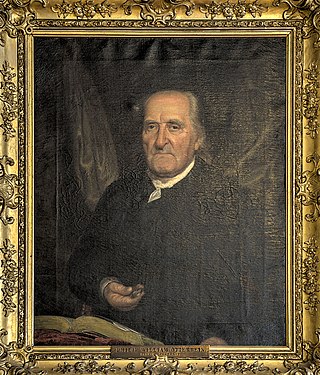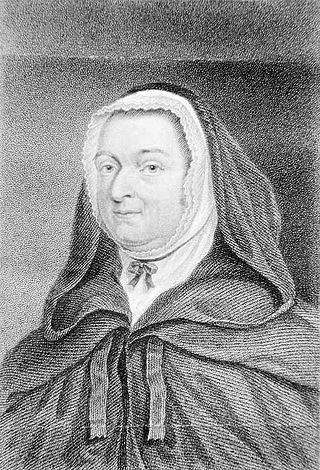Related Research Articles
Methodism, also called the Methodist movement, is a group of historically related denominations of Protestant Christianity whose origins, doctrine and practice derive from the life and teachings of John Wesley. George Whitefield and John's brother Charles Wesley were also significant early leaders in the movement. They were named Methodists for "the methodical way in which they carried out their Christian faith". Methodism originated as a revival movement within Anglicanism originating out of the Church of England in the 18th century and became a separate denomination after Wesley's death. The movement spread throughout the British Empire, the United States and beyond because of vigorous missionary work, and today has about 80 million adherents worldwide.

John Wesley was an English cleric, theologian, and evangelist who was a leader of a revival movement within the Church of England known as Methodism. The societies he founded became the dominant form of the independent Methodist movement that continues to this day.
The Methodist Episcopal Church (MEC) was the oldest and largest Methodist denomination in the United States from its founding in 1784 until 1939. It was also the first religious denomination in the US to organize itself nationally. In 1939, the MEC reunited with two breakaway Methodist denominations to form the Methodist Church. In 1968, the Methodist Church merged with the Evangelical United Brethren Church to form the United Methodist Church.
The Methodist Episcopal Church, South was the American Methodist denomination resulting from the 19th-century split over the issue of slavery in the Methodist Episcopal Church (MEC). Disagreement on this issue had been increasing in strength for decades between churches of the Northern and Southern United States; in 1845 it resulted in a schism at the General Conference of the MEC held in Louisville, Kentucky.

The First Great Awakening or the Evangelical Revival was a series of Christian revivals that swept Britain and its thirteen North American colonies in the 1730s and 1740s. The revival movement permanently affected Protestantism as adherents strove to renew individual piety and religious devotion. The Great Awakening marked the emergence of Anglo-American evangelicalism as a trans-denominational movement within the Protestant churches. In the United States, the term Great Awakening is most often used, while in the United Kingdom, the movement is referred to as the Evangelical Revival.

Griffith Jones was a Welsh minister of the Church of England and a promoter of Methodism. He is best known for spreading literacy in Wales with his circulating schools.

Anna Howard Shaw was a leader of the women's suffrage movement in the United States. She was also a physician and one of the first ordained female Methodist ministers in the United States.
Connexionalism, also spelled connectionalism, is the theological understanding and foundation of Methodist ecclesiastical polity, as practised in the Methodist Church in Britain, Methodist Church in Ireland, United Methodist Church, Free Methodist Church, African Methodist Episcopal Church, African Methodist Episcopal Zion Church, Bible Methodist Connection of Churches, Christian Methodist Episcopal Church, Methodist Church in the Caribbean and the Americas, and many of the countries where Methodism was established by missionaries sent out from these churches. It refers to the way in which Methodist churches and other institutions are connected and work together to support one another, share resources, and carry out mission and ministry. The United Methodist Church defines connection as the principle that "all leaders and congregations are connected in a network of loyalties and commitments that support, yet supersede, local concerns." Accordingly, the primary decision-making bodies in Methodism are conferences, which serve to gather together representatives of various levels of church hierarchy.

Philip William Otterbein was an American clergyman. He was the founder of the United Brethren in Christ, which merged with the Evangelical Church in 1946 to form the Evangelical United Brethren Church. That church merged with the much larger Methodist Church in 1968, forming the United Methodist Church.

A watchnight service is a late-night Christian church service. In many different Christian traditions, such as those of Moravians, Methodists, Catholics, Lutherans, Anglicans, Baptists, Adventists and Reformed Christians, watchnight services are held late on New Year's Eve, which is the seventh day of Christmastide. This provides the opportunity for Christians to review the year that has passed and make confession, and then prepare for the year ahead by praying and resolving. The services often include singing, praying, exhorting, preaching, and Holy Communion.
Thomas Burch (1778–1849) was an early nineteenth-century Methodist circuit rider in the United States and Canada.

Mary Bosanquet Fletcher was an English preacher credited with persuading John Wesley, a founder of Methodism, to allow women to preach in public. She was born into an affluent family, but after converting to Methodism, rejected its luxurious life. She was involved in charity work throughout her life, operating a school and orphanage until her marriage to John Fletcher. She and a friend, Sarah Crosby, began preaching and leading meetings at her orphanage and became the most popular female preachers of their time. Fletcher was known as a "Mother in Israel", a Methodist term of honour, for her work in spreading the denomination across England.

The history of Methodism in the United States dates back to the mid-18th century with the ministries of early Methodist preachers such as Laurence Coughlan and Robert Strawbridge. Following the American Revolution most of the Anglican clergy who had been in America came back to England. John Wesley, the founder of Methodism, sent Thomas Coke to America where he and Francis Asbury founded the Methodist Episcopal Church, which was to later establish itself as the largest denomination in America during the 19th century.
Sarah Crosby was an English Methodist preacher, and is considered to be the first woman to hold this title. Crosby, along with Mary Bosanquet, are the most popular women preachers of Methodism. Scholars such as Paul Wesley Chilcote consider Crosby to be the busiest female Methodist preacher, as she preached up until the day she died. She was also renowned for being skilled at prayer, which at the time was seen as a sort of religious art form.

Electa Quinney was a Mohican and member of the Stockbridge-Munsee Community. She founded one of the first schools in what would become Wisconsin and was the first woman to teach in a public school in the territory which would be Wisconsin.
Howel Davies was a Welsh Methodist minister. Little is known about his early life, but by 1737 he is known to have been a schoolmaster at Talgarth. There he was converted by Howel Harris, and on Harris's advice he went to Llanddowror to study under Griffith Jones. In 1739 he was ordained deacon, and then a priest in 1740. He served initially at the church in Llandeilo Abercywyn, before moving in 1741 to Llys y Fran, Pembrokeshire. Along with Harris and Jones, he made a major contribution to the spread of Calvinistic Methodism in Pembrokeshire, so much so that he became known as "the Apostle of Pembrokeshire".
In Methodism, a steward is a member of a local church who is elected by the congregation to help in the practical life of the church. The position of stewards is a hallmark of classic Methodism.
Sarah Jane Lancaster was the leader of Australia's first Pentecostal congregation. An evangelist and administrator, she established a printing press in her meeting hall to produce evangelistic tracts and pamphlets. Lancaster also published Australia's first Pentecostal magazine, Good News. Lancaster became president of the nation's earliest attempt to organise Pentecostalism into a denomination, the Apostolic Faith Mission of Australasia. Although she is recognised as the founder of Australian Pentecostalism and contributed to the unique prominence of women in the founding of Australian Pentecostal congregations, many of her doctrinal ideas were quickly abandoned as the movement developed.
References
- 1 2 Lybrand 1884, p. 66.
- 1 2 3 Lybrand 1884, p. 61.
- 1 2 3 Lybrand 1884, p. 62.
- 1 2 3 4 Lednum 1859, p. 43.
- 1 2 Matthews 2007, p. 33.
- ↑ Lybrand 1884, p. 67.
- 1 2 Lybrand 1884, p. 68.
- 1 2 Richey, Rowe & Schmidt 2010, p. 54.
- 1 2 Lybrand 1884, p. 64.
- 1 2 Lybrand 1884, p. 65.
- ↑ Lybrand 1884, p. 69.
- ↑ Lednum 1859, p. 44.